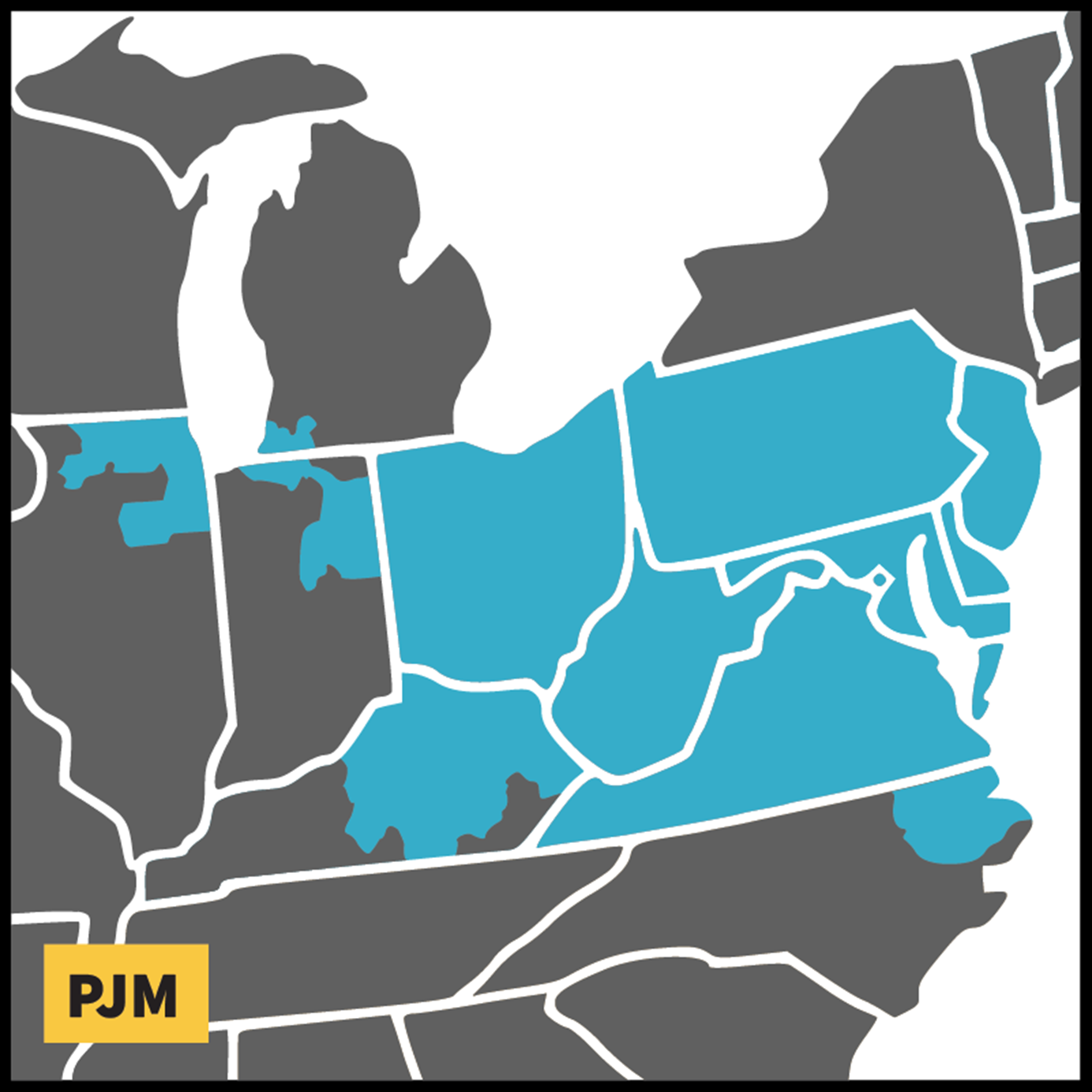
Some readers may recall headlines last fall stating that the PJM Interconnection would stop accepting energy efficiency resources for its forward capacity auctions. Capacity auctions work in the following simplified process:
- Local distribution companies, aka utilities, determine peak load contributions at multiple levels of aggregation – e.g., zonal and network transmission[1].
- PJM aggregates those loads and adds reserve margins to ensure there will always be enough power to keep the grid energized at specified voltages and 60 Hz alternating current frequency.
- Capacity providers, including generators and demand side and load management aggregators, bid their resources into the market until the aggregated loads plus reserve margins are met (cleared). These generators aggregate for something called a supply or generation stack.
- The last bid that clears the load plus margin sets all suppliers’ prices.
Figure 1 PJM Territory
 Last fall, PJM excluded energy efficiency resources from the auction. Why? They said that energy efficiency resources reduce the peak load contribution, as noted in the first bullet above. It’s already accounted for and, in many cases, funded by energy efficiency programs. Ok. I get that. But there was a lot more to the story than readers and I knew about.
Last fall, PJM excluded energy efficiency resources from the auction. Why? They said that energy efficiency resources reduce the peak load contribution, as noted in the first bullet above. It’s already accounted for and, in many cases, funded by energy efficiency programs. Ok. I get that. But there was a lot more to the story than readers and I knew about.
This Rant is brought to you by AESP’s weekly newsletter, Energy Feed. Specifically, the Feed introduced me to this article: Is FERC’s Future at Stake in its Titanic Clash with American Efficient? You read that right. I had to read it four or five times and ultimately gave up. Is this a typo? Is “American” the name of a company? How is a clash efficient? It sounds very inefficient. Answer: “American Efficient” is the company name.
American Inefficient
American Efficient is the largest “energy efficiency” company and aggregator you have never heard of, and it is the foundation of PJM’s rejection of energy efficiency as a capacity resource in its auction.
You won’t believe American Efficient’s business model. Straight from the article: “It buys sales data and “environmental attributes”—the inherent characteristics of lightbulbs, appliances, caulk and other products that make them energy efficient—from large retailers, like Lowe’s, The Home Depot and Walmart, as well as lighting manufacturers and distributors.
“The company calculates the energy savings from the anticipated use of those products and bids the savings at capacity auctions. These auctions are hosted by electric grid operators, such as ISO New England, the Midcontinent Independent System Operator (MISO), and PJM Interconnection, where they buy future supplies of electricity on the wholesale market from power producers and energy efficiency aggregators.”
Makings of Gangsters
Remember Electrification Gangsters from a few weeks ago. That case to electrify Ithaca, New York, involved bait, switch, run, and hide. Not mentioned were scavengers and parasites who swarm to jurisdictions to grab all they can get with both hands and disregard the program’s mission. American Efficient has been taking credit for the sunrise for years. The Federal Energy Regulatory Commission (FERC), PJM, and the Midcontinent Independent System Operator have finally noticed.
According to Utility Dive, a FERC report states, “American Efficient’s program receives more capacity payments than any single generator in PJM, and offers nothing in return.” American Efficient owes nearly one billion (pinky alert) dollars of penalties and profit forfeitures. By 2023, it accounted for 75% of PJM’s efficiency resource bid, including 4.2 GIGAwatts of capacity in one year! PJM would include efficiency bids from entire portfolios utilities like PEPCO, Baltimore Gas and Electric, PPL, PECO, First Energy, ComEd, and Dominion Energy.
FERC contends American Efficient’s program “fails to meet provisions in the PJM and MISO tariffs because it doesn’t reduce electricity use, lacks the nexus to end-use customer projects required by those tariffs and does not include the required ownership or contractual rights in end-use customer projects.”
Inside Climate News reports, “FERC investigators allege American Efficient misled grid operators about the true nature of its program. The company did not actually cause reductions in energy consumption, according to investigators. And after paying the big box stores and appliance manufacturers to sell more energy efficient products, American Efficient never made sure that they actually did.”
Everything is For Sale
My response to “It’s not for sale” is, “Sure, it is if the price is right.” Although FERC may think American Efficient paid retailers to sell more efficient equipment, the retailers were only selling sales data from my perspective. Prove it, Jeff. Well, Inside Climate News reports incentive payments of 19 cents for clothes washers and 12 cents for refrigerators. There is a name for that in our industry: free riders. Selling sales data is like selling a knife, rope, or candlestick[2] – perfectly safe and legal, but the seller has no control over the crime the buyer may commit with the purchase.
RTO Embarrassment
Shame on the grid operators – especially PJM. FERC is basing its case on the “incredible notion that the [grid operators] either were hoodwinked by American Efficient or, worse, were simply incompetent in overseeing their markets—for the last 10 years. No court will find that theory remotely credible.”
We (Michaels) have painstakingly prepared utility efficiency program data for bidding into PJM and ISO-New England capacity markets. Why bother when hucksters like American Efficient report retail sales data in exchange for hundreds of millions in RTO capacity payments?
Sure enough, ISO-New England was the first to smell the rotten stench in 2018 when American Efficient’s greed overexposed their scam. They attempted to increase their bid by 20X in one shot. That was about as covert as breaking wind at a funeral service. Well played!
MISO was next to investigate American Efficient’s fraud, leaving PJM last to investigate. Isn’t it interesting that the RTO that despises energy efficiency resources was taken advantage of for the longest time and was the most damaged by EE swindlers?
Schyster Maneuvers
What do schysters do when they can’t win on the merits, perp fraud, or unethically exploit a market? File lawsuits on technicalities. A billion dollars can buy a lot of legal challenges to the federal government. Read up on the Climate News article. My bet is that the FERC is constitutional because it regulates interstate commerce. Whether it can exact penalties, I’m less certain.
[1]https://supplier.bge.com/electric/load/plcs.asp
[2]https://www.amazon.com/Replacement-Weapons-Pewter-Candlestick-Revolver/dp/B00O83PO2O
